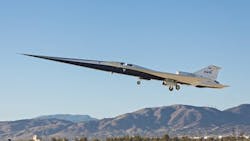Lockheed Martin Skunk Works Completes First Successful Flight of Supersonic X-59
Lockheed Martin Skunk Works has successfully flown the X-59 for the first time, in collaboration with NASA. The X-59 is a supersonic aircraft designed for quieter, faster commercial air travel.
The X-59 flew from Palmdale, California, to Edwards, California, traveling from Skunk Works's U.S. Air Force Plant 42 facility to NASA's Armstrong Flight Research Center. The X-59 verified initial flying qualities and air data performance, completing a successful flight.
"We are thrilled to achieve the first flight of the X-59," said OJ Sanchez, vice president and general manager of Lockheed Martin Skunk Works, "This aircraft is a testament to the innovation and expertise of our joint team, and we are proud to be at the forefront of quiet supersonic technology development."
The X-59 is a next-generation supersonic aircraft that aims to reduce the sonic boom while flying at supersonic speeds. As the noise level of the sonic boom is cause for concern in many areas, particularly regarding land being flown over, Lockheed Martin Skunkworks hopes to mitigate this barrier to supersonic commercial flight with the X-59.
Following the X-59's development and successful flight testing, it could be easier to establish new data-driven acceptable noise thresholds related to supersonic commercial flight over land. This could make it possible for new supersonic aircraft to start transporting passengers and cargo, offering benefits like:
- Efficient operations
- Enhanced sustainability
- Increased aircraft speed
"X-59 is a symbol of American ingenuity. The American spirit knows no bounds. It's part of our DNA—the desire to go farther, faster and even quieter than anyone has ever gone before. This work sustains America's place as the leader in aviation and has the potential to change the way the public flies," said Sean Duffy, acting NASA Administrator.
Skunk Works will keep leading the aircraft's initial flight test campaign, collaborating with NASA to expand the X-59's flight envelope. This will include the X-59's first supersonic flights, where it will achieve the optimal speed and altitude for a quiet boom, allowing NASA to measure the X-59’s sound signature and conduct community acceptance testing.
